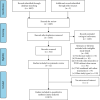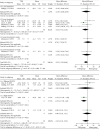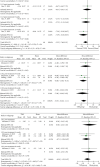Repetitive Transcranial Magnetic Stimulation for Neuropathic Pain and Neuropsychiatric Symptoms in Traumatic Brain Injury: A Systematic Review and Meta-Analysis
- PMID: 35945967
- PMCID: PMC9357260
- DOI: 10.1155/2022/2036736
Repetitive Transcranial Magnetic Stimulation for Neuropathic Pain and Neuropsychiatric Symptoms in Traumatic Brain Injury: A Systematic Review and Meta-Analysis
Abstract
Neuropathic pain and neuropsychiatric symptoms are common complications reported by the traumatic brain injury (TBI) population. Although a growing body of research has indicated the effectiveness of repetitive transcranial magnetic stimulation (rTMS) for the management of neurological and psychiatric disorders, little evidence has been presented to support the effects of rTMS on neuropathic pain and neuropsychiatric symptoms in patients with TBI in all age groups. In addition, a better understanding of the potential factors that might influence the therapeutic effect of rTMS is necessary. The objective of this preregistered systematic review and meta-analysis was to quantify the effects of rTMS on physical and psychological symptoms in individuals with TBI. We systematically searched six databases for randomized controlled trials (RCTs) of rTMS in TBI patients reporting pain and neuropsychiatric outcomes published until March 20, 2022. The mean difference (MD) with 95% confidence intervals (CIs) was estimated separately for outcomes to understand the mean effect size. Twelve RCTs with 276 TBI patients were ultimately selected from 1605 records for systematic review, and 11 of the studies were included in the meta-analysis. Overall, five of the included studies showed a low risk of bias. The effects of rTMS on neuropathic pain were statistically significant (MD = -1.00, 95% CI -1.76 to -0.25, P = 0.009), with high heterogeneity (I 2 = 76%). A significant advantage of 1 Hz rTMS over the right dorsolateral prefrontal cortex (DLPFC) in improving depression (MD = -6.52, 95% CI -11.58 to -1.46, P = 0.01) was shown, and a significant improvement was noted in the Rivermead Post-Concussion Symptoms Questionnaire-13 (RPQ-13) scores of mild TBI patients after rTMS (MD = -5.87, 95% CI -10.63 to -1.11, P = 0.02). However, no significance was found in cognition measurement. No major adverse events related to rTMS were reported. Moderate evidence suggests that rTMS can effectively and safely improve neuropathic pain, while its effectiveness on depression, postconcussion symptoms, and cognition is limited. More trials with a larger number of participants are needed to draw firm conclusions. This trial is registered with PROSPERO (PROSPERO registration number: CRD42021242364.
Copyright © 2022 Xin Li et al.
Conflict of interest statement
The authors declare that there are no conflicts of interest regarding the publication of this paper.
Figures









Similar articles
-
Non-invasive brain stimulation techniques for chronic pain.Cochrane Database Syst Rev. 2018 Mar 16;3(3):CD008208. doi: 10.1002/14651858.CD008208.pub4. Cochrane Database Syst Rev. 2018. Update in: Cochrane Database Syst Rev. 2018 Apr 13;4:CD008208. doi: 10.1002/14651858.CD008208.pub5. PMID: 29547226 Free PMC article. Updated.
-
Non-invasive brain stimulation techniques for chronic pain.Cochrane Database Syst Rev. 2018 Apr 13;4(4):CD008208. doi: 10.1002/14651858.CD008208.pub5. Cochrane Database Syst Rev. 2018. PMID: 29652088 Free PMC article.
-
Interventions for the management of abdominal pain in Crohn's disease and inflammatory bowel disease.Cochrane Database Syst Rev. 2021 Nov 29;11(11):CD013531. doi: 10.1002/14651858.CD013531.pub2. Cochrane Database Syst Rev. 2021. PMID: 34844288 Free PMC article.
-
Interventions for the treatment of brain radionecrosis after radiotherapy or radiosurgery.Cochrane Database Syst Rev. 2018 Jul 9;7(7):CD011492. doi: 10.1002/14651858.CD011492.pub2. Cochrane Database Syst Rev. 2018. PMID: 29987845 Free PMC article.
-
Physical activity for treatment of irritable bowel syndrome.Cochrane Database Syst Rev. 2022 Jun 29;6(6):CD011497. doi: 10.1002/14651858.CD011497.pub2. Cochrane Database Syst Rev. 2022. PMID: 35766861 Free PMC article.
Cited by
-
Treatment of cognitive and mood disorders secondary to traumatic brain injury by the association of bilateral occipital nerve stimulation and a combined protocol of multisite repetitive transcranial magnetic stimulation and cognitive training: A case report.Front Neurol. 2023 Nov 7;14:1195513. doi: 10.3389/fneur.2023.1195513. eCollection 2023. Front Neurol. 2023. PMID: 38020613 Free PMC article.
-
Effect of virtual reality combined with repetitive transcranial magnetic stimulation on musculoskeletal pain and motor development in children with spastic cerebral palsy: a protocol for a randomized controlled clinical trial.BMC Neurol. 2023 Sep 26;23(1):339. doi: 10.1186/s12883-023-03359-4. BMC Neurol. 2023. PMID: 37752420 Free PMC article.
-
The Rehabilitation Potential of Neurostimulation for Mild Traumatic Brain Injury in Animal and Human Studies.Brain Sci. 2023 Sep 30;13(10):1402. doi: 10.3390/brainsci13101402. Brain Sci. 2023. PMID: 37891771 Free PMC article. Review.
-
Excitatory Dorsal Lateral Prefrontal Cortex Transcranial Magnetic Stimulation Increases Social Anxiety.Brain Sci. 2023 Jun 24;13(7):989. doi: 10.3390/brainsci13070989. Brain Sci. 2023. PMID: 37508921 Free PMC article.
-
Individually guided neuromodulation in special operator veterans with symptoms of PTSD and traumatic brain injury: preliminary data from a chart review.Front Neurol. 2025 Feb 13;16:1495034. doi: 10.3389/fneur.2025.1495034. eCollection 2025. Front Neurol. 2025. PMID: 40017534 Free PMC article.
References
-
- Dewan M. C., Rattani A., Gupta S., et al. Estimating the global incidence of traumatic brain injury. Journal of Neurosurgery . 2018;130(4):1080–1097. - PubMed
-
- Nelson L. D., Temkin N. R., Dikmen S., et al. Recovery after mild traumatic brain injury in patients presenting to US level I trauma centers: a Transforming Research and Clinical Knowledge in Traumatic Brain Injury (TRACK-TBI) study. JAMA Neurology . 2019;76(9):1049–1059. doi: 10.1001/jamaneurol.2019.1313. - DOI - PMC - PubMed
-
- Rossi S., Hallett M., Rossini P. M., Pascual-Leone A., Safety of TMS Consensus Group Safety, ethical considerations, and application guidelines for the use of transcranial magnetic stimulation in clinical practice and research. Clinical Neurophysiology: Official Journal of the International Federation of Clinical Neurophysiology . 2009;120(12):2008–2039. doi: 10.1016/j.clinph.2009.08.016. - DOI - PMC - PubMed
Publication types
MeSH terms
LinkOut - more resources
Full Text Sources
Medical

